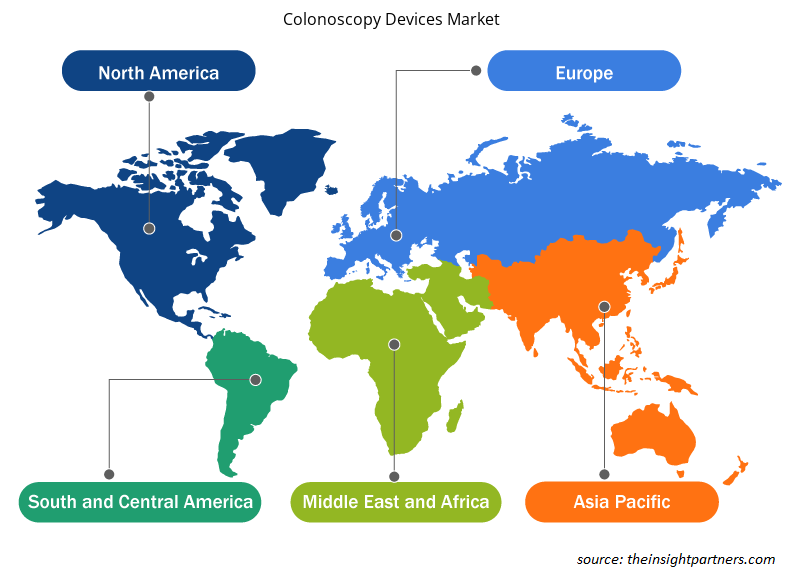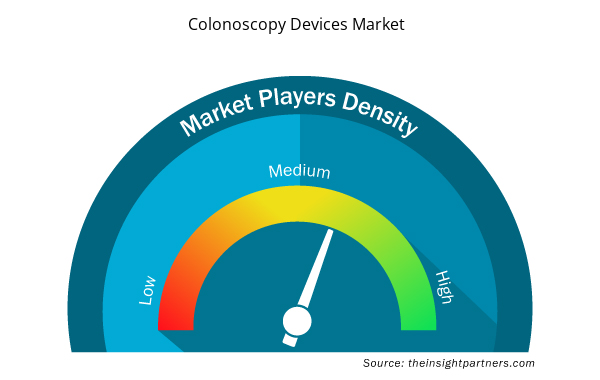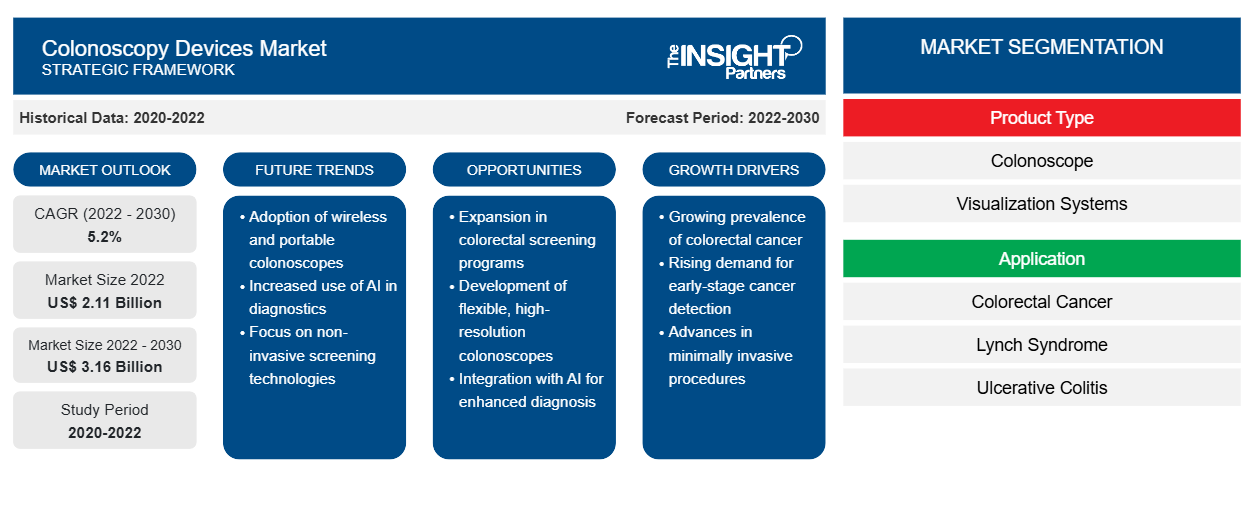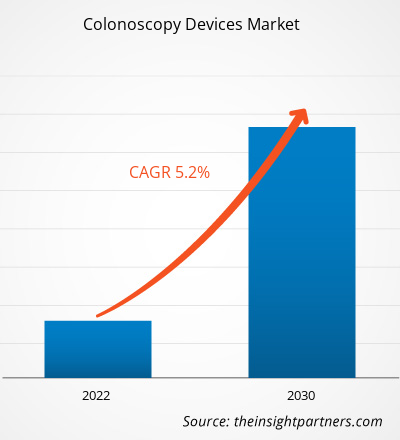[Forschungsbericht] Der Markt für Koloskopiegeräte soll von 2,11 Milliarden US-Dollar im Jahr 2022 auf 3,16 Milliarden US-Dollar im Jahr 2030 wachsen und im Zeitraum 2022–2030 eine durchschnittliche jährliche Wachstumsrate von 5,2 % verzeichnen.
Markteinblicke und Analystenansichten:
Die Marktprognose für Koloskopiegeräte kann den Beteiligten in diesem Markt bei der Planung ihrer Wachstumsstrategien helfen. Der Bericht enthält Wachstumsaussichten sowie die Markttrends für Koloskopiegeräte und ihre vorhersehbaren Auswirkungen während des Prognosezeitraums.
Koloskopien werden mit wiederverwendbaren Endoskopen durchgeführt. Dabei handelt es sich um flexible, faseroptische Instrumente, die in den Anus eingeführt und durch den Dickdarm geleitet werden. Die Koloskope helfen Endoskopikern, chronische Krankheiten zu erkennen und Patienten auf bösartige oder präkanzeröse Erkrankungen zu untersuchen. Personen ab 50 Jahren sollten sich im Rahmen einer regelmäßigen Krebsvorsorge einer Koloskopie unterziehen. In Krankenhäusern oder ambulanten Operationszentren ( ASCs ) werden die Verfahren unter leichter Sedierung durchgeführt. Die steigende Prävalenz von Dickdarmkrebs und die zunehmenden technologischen Fortschritte der Hersteller bei Koloskopiegeräten tragen zum wachsenden Markt für Koloskopiegeräte bei. Die Verfügbarkeit alternativer Diagnosetests für Rektalerkrankungen behindert jedoch das Wachstum des Marktes.
Wachstumstreiber:
Steigende Prävalenz von Dickdarmkrebs treibt das Marktwachstum bei Koloskopiegeräten an
Kolorektaler Krebs ist ein bösartiger Tumor, der sich im Gewebe des Rektums oder Dickdarms bildet. Rektum- und Dickdarmkrebs werden aufgrund der gemeinsamen Merkmale beider Erkrankungen oft zusammengefasst. Laut der Weltgesundheitsorganisation (WHO) steht Dickdarmkrebs im Hinblick auf die weltweit zweithäufigsten krebsbedingten Todesfälle an erster Stelle. Weltweit gab es im Jahr 2020 über 1,9 Millionen neue Fälle von Dickdarmkrebs und über 930.000 Todesfälle aufgrund der Krankheit. Es gab erhebliche regionale Unterschiede bei den Inzidenz- und Sterberaten. Europa, Australien und Neuseeland meldeten die höchsten Inzidenzraten, während Osteuropa die höchsten Sterberaten aufwies. Laut den Daten des Europäischen Krebsinformationssystems machte Dickdarmkrebs in den 27 EU-Ländern im Jahr 2020 12,7 % aller neuen Krebsdiagnosen und 12,4 % aller durch die Krankheit verursachten Todesfälle aus . Aufgrund seiner hohen Prävalenz ist er nach Brustkrebs die zweithäufigste Krebsart und nach Lungenkrebs die zweithäufigste Todesursache in Europa. Nach Angaben der WHO gab es im Jahr 2020 mehr als 1,9 Millionen neue Fälle von Dickdarmkrebs . Bis 2040 dürfte die jährliche Belastung durch Dickdarmkrebs auf 3,2 Millionen Neuerkrankungen (ein Anstieg um 63 %) und 1,6 Millionen Todesfälle (ein Anstieg um 73 %) ansteigen.
In den USA ist Dickdarmkrebs die dritthäufigste Krebsart ( Hautkrebs ausgenommen ), die jedes Jahr diagnostiziert wird. Laut der American Cancer Society wurden im Jahr 2023 in den USA etwa 153.000 Menschen mit Dickdarmkrebs diagnostiziert . Diese Zahlen umfassen 106.950 neue Fälle von Dickdarmkrebs (54.420 Männer und 52.550 Frauen) und 46.050 neue Fälle von Mastdarmkrebs (27.440 Männer und 18.610 Frauen). Bei Dickdarmkrebs ist die Koloskopie ein wichtiger Screening-Test und ist zu einem Teil der routinemäßigen Krebsvorsorge geworden. Daher treibt die zunehmende Prävalenz von Dickdarmkrebs das Wachstum des Marktes für Koloskopiegeräte voran.
Alternativen zur Koloskopie sind die Sigmoidoskopie , eine weniger invasive Form der Koloskopie, und die Untersuchung von Stuhlproben, eine der nichtinvasiven Methoden. Seit Beginn des 21. Jahrhunderts empfehlen Ärzte häufig eine Koloskopie, um Patienten ab 50 Jahren auf Dickdarmkrebs zu untersuchen. In den letzten Jahren haben sie jedoch das Bedürfnis nach einer Änderung ihrer Vorgehensweise verspürt. Sie sind besorgt über die Kosten und den Aufwand einer Koloskopie, was die Menschen davon abhält, sich diesen Vorsorgeuntersuchungen zu unterziehen. Darüber hinaus gibt es ebenso wirksame Tests, die weniger invasiv und weniger anstrengend sind als eine Koloskopie. Daher behindert die Verfügbarkeit alternativer Diagnosetests das Wachstum des Marktes für Koloskopiegeräte.
Passen Sie diesen Bericht Ihren Anforderungen an
Sie erhalten kostenlose Anpassungen an jedem Bericht, einschließlich Teilen dieses Berichts oder einer Analyse auf Länderebene, eines Excel-Datenpakets sowie tolle Angebote und Rabatte für Start-ups und Universitäten.
- Holen Sie sich die wichtigsten Markttrends aus diesem Bericht.Dieses KOSTENLOSE Beispiel umfasst eine Datenanalyse von Markttrends bis hin zu Schätzungen und Prognosen.
Berichtssegmentierung und -umfang:
Die Marktanalyse für Koloskopiegeräte wurde unter Berücksichtigung der folgenden Segmente durchgeführt: Produkttyp, Anwendung und Endbenutzer.
Segmentanalyse :
Nach Produkttyp ist der Markt für Koloskopiegeräte in Koloskope , Visualisierungssysteme und Sonstiges unterteilt. Das Segment Koloskope hatte 2022 den größten Marktanteil. Es wird jedoch erwartet, dass das Segment Visualisierungssysteme zwischen 2022 und 2030 die höchste durchschnittliche jährliche Wachstumsrate verzeichnet.
Der Markt für Koloskopiegeräte ist nach Anwendung in Dickdarmkrebs , Lynch-Syndrom, Colitis ulcerosa , Morbus Crohn und andere unterteilt. Das Segment Dickdarmkrebs hatte 2022 den größten Marktanteil bei Koloskopiegeräten, und es wird erwartet, dass dasselbe Segment zwischen 2022 und 2030 die höchste durchschnittliche jährliche Wachstumsrate verzeichnet . Die Koloskopie kann bösartige und pro-maligne Läsionen mit hoher Genauigkeit erkennen und entfernen. Sie ist ein wertvolles Diagnoseinstrument für die Darmkrebsvorsorge . Fast alle nationalen und internationalen Magen-Darm- und Krebsgesellschaften empfehlen, sie als erste Vorsorgemethode zu verwenden.
Der Markt für Koloskopiegeräte ist nach Endverbraucher in Krankenhäuser, ambulante Operationszentren und andere unterteilt. Das Krankenhaussegment hatte 2022 den größten Marktanteil bei Koloskopiegeräten und wird voraussichtlich zwischen 2022 und 2030 die höchste durchschnittliche jährliche Wachstumsrate verzeichnen , was auf die Einführung technologischer Fortschritte in Krankenhäusern und die zunehmende Anzahl von Screenings in Krankenhäusern zurückzuführen ist.
Regionale Analyse:
Der geografische Umfang des Marktberichts für Koloskopiegeräte umfasst Nordamerika, Europa, den asiatisch-pazifischen Raum, den Nahen Osten und Afrika sowie Süd- und Mittelamerika. Nordamerika hatte im Jahr 2022 den größten Marktanteil. Das Marktwachstum in Nordamerika wird durch die zunehmende Belastung der alternden Bevölkerung, die steigende Zahl von Produkteinführungen und F&E-Aktivitäten zur Entwicklung fortschrittlicher Koloskopiegeräte vorangetrieben.
Regionale Einblicke in den Markt für Koloskopiegeräte
Die regionalen Trends und Faktoren, die den Markt für Koloskopiegeräte im Prognosezeitraum beeinflussen, wurden von den Analysten von Insight Partners ausführlich erläutert. In diesem Abschnitt werden auch die Marktsegmente und die Geografie für Koloskopiegeräte in Nordamerika, Europa, im asiatisch-pazifischen Raum, im Nahen Osten und Afrika sowie in Süd- und Mittelamerika erörtert.

- Erhalten Sie regionale Daten zum Markt für Koloskopiegeräte
Umfang des Marktberichts über Koloskopiegeräte
| Berichtsattribut | Details |
|---|---|
| Marktgröße im Jahr 2022 | 2,11 Milliarden US-Dollar |
| Marktgröße bis 2030 | 3,16 Milliarden US-Dollar |
| Globale CAGR (2022 - 2030) | 5,2 % |
| Historische Daten | 2020-2022 |
| Prognosezeitraum | 2022–2030 |
| Abgedeckte Segmente | Nach Produkttyp
|
| Abgedeckte Regionen und Länder | Nordamerika
|
| Marktführer und wichtige Unternehmensprofile |
|
Marktteilnehmerdichte für Koloskopiegeräte: Auswirkungen auf die Geschäftsdynamik verstehen
Der Markt für Koloskopiegeräte wächst rasant, angetrieben durch die steigende Nachfrage der Endnutzer aufgrund von Faktoren wie sich entwickelnden Verbraucherpräferenzen, technologischen Fortschritten und einem größeren Bewusstsein für die Vorteile des Produkts. Mit steigender Nachfrage erweitern Unternehmen ihr Angebot, entwickeln Innovationen, um die Bedürfnisse der Verbraucher zu erfüllen, und nutzen neue Trends, was das Marktwachstum weiter ankurbelt.
Die Marktteilnehmerdichte bezieht sich auf die Verteilung der Firmen oder Unternehmen, die in einem bestimmten Markt oder einer bestimmten Branche tätig sind. Sie gibt an, wie viele Wettbewerber (Marktteilnehmer) in einem bestimmten Marktraum im Verhältnis zu seiner Größe oder seinem gesamten Marktwert präsent sind.
Die wichtigsten auf dem Markt für Koloskopiegeräte tätigen Unternehmen sind:
- AMBU AS
- Fujifilm
- Endomed systems gmbh
- Olymp
- Pentax
Haftungsausschluss : Die oben aufgeführten Unternehmen sind nicht in einer bestimmten Reihenfolge aufgeführt.

- Überblick über die wichtigsten Akteure auf dem Markt für Koloskopiegeräte
Wettbewerbslandschaft und Schlüsselunternehmen:
AMBU AS, Fujifilm, Endomed Systems GmbH, Olympus, Steris PLC, GI View, Boston Scientific Corporation, PENTAX Medical, Avantis Medical Systems und SonoScape Medical Corp gehören zu den führenden Unternehmen, die im Marktbericht für Koloskopiegeräte vorgestellt werden. Diese Unternehmen konzentrieren sich auf die Entwicklung neuer Technologien, die Verbesserung bestehender Produkte und die Ausweitung ihrer geografischen Präsenz, um der wachsenden weltweiten Verbrauchernachfrage gerecht zu werden. Laut Pressemitteilungen der Unternehmen sind im Folgenden einige aktuelle Schlüsselentwicklungen aufgeführt: AS, Fujifilm, Endomed systems gmbh, Olympus, Steris PLC, GI View, Boston Scientific Corporation, PENTAX Medical, Avantis Medical Systems, and SonoScape Medical Corp are among the prominent companies profiled in the colonoscopy devices market report. These companies focus on developing new technologies, upgrading existing products, and expanding their geographic presence to meet the growing consumer demand worldwide. As per company press releases, below are a few recent key developments:
- Im April 2021 brachte FUJIFILM Medical Systems das Koloskop der G-EYE 700-Serie auf den Markt. G-EYE, eine von Smart Medical entwickelte Technologie, unterstützt bei Routineuntersuchungen. Die Koloskope der G-EYE 700-Serie erweiterten das innovative Koloskop-Portfolio von Fujifilm. G-EYE wird als Erweiterung der Koloskop-Familie der 700-Serie angeboten, die mit dem endoskopischen Videobildgebungssystem ELUXEO von Fujifilm kompatibel ist.FUJIFILM Medical Systems launched the G-EYE 700 Series Colonoscope. G-EYE, a technology developed by Smart Medical, assists during routine examinations. The G-EYE 700 series colonoscopes expanded Fujifilm’s innovative colonoscope portfolio offering. G-EYE will be offered as an extension to the 700-series colonoscope family that is compatible with Fujifilm’s ELUXEO endoscopic video imaging system.
- Im Oktober 2020 erhielt Olympus die 510(k)-Zulassung und Marktverfügbarkeit für seine beiden Koloskope PCF-H190T und PCF-HQ190. Die Produkte erweiterten die bestehenden Möglichkeiten der Ärzte zur Diagnose und Behandlung von Erkrankungen des Magen-Darm-Trakts.colonoscopes—PCF-H190T and PCF-HQ190. The products provided an addition to the present capabilities for physicians to diagnose and treat gastrointestinal tract disorders.
- Historische Analyse (2 Jahre), Basisjahr, Prognose (7 Jahre) mit CAGR
- PEST- und SWOT-Analyse
- Marktgröße Wert/Volumen – Global, Regional, Land
- Branche und Wettbewerbsumfeld
- Excel-Datensatz


- Electronic Signature Software Market
- Medical Collagen Market
- Organoids Market
- Visualization and 3D Rendering Software Market
- Hydrocephalus Shunts Market
- Excimer & Femtosecond Ophthalmic Lasers Market
- Bathroom Vanities Market
- Truck Refrigeration Market
- Latent TB Detection Market
- Mail Order Pharmacy Market

Report Coverage
Revenue forecast, Company Analysis, Industry landscape, Growth factors, and Trends

Segment Covered
This text is related
to segments covered.

Regional Scope
North America, Europe, Asia Pacific, Middle East & Africa, South & Central America

Country Scope
This text is related
to country scope.
Häufig gestellte Fragen
The colonoscopy devices market majorly consists of players such as AMBU AS, Fujifilm, Endomed systems gmbh, Olympus, Steris PLC, GI View, Boston Scientific Corporation, PENTAX Medical, Avantis Medical Systems, and SonoScape Medical Corp among others.
US holds the largest market share in colonoscopy devices market due to the increasing public awareness of colon cancer through media campaigns initiated by cancer awareness groups and government agencies, and an aging population who are encouraged to have regular checkups. According to the American Cancer Society, an estimated 104,610 new colon cancer cases and 43,340 rectal cancer cases were diagnosed in the US in 2020.
The factors that are driving the growth of the market are the rising prevalence of colorectal cancer and increasing technological advancements in colonoscopy devices by manufacturers.
Asia Pacific is expected to be the fastest-growing region in the colonoscopy devices market. The colonoscopy devices market in the region is driven by factors such as an increasing number of R&D activities, adoption of innovative technology and products, and upsurging prevalence of chronic diseases in this region.
Colonoscopies are performed with reusable scopes. They are flexible, fiber-optic instruments that are introduced into the anus and directed through the colon. The colonoscopes helps endoscopists detect chronic illnesses and check patients for malignant or precancerous diseases. People aged 50 years and above should get colonoscopies as part of a regular cancer screening regimen. In hospitals or ambulatory surgery center (ASCs), the procedures are carried out under mild sedation.
The colonoscopy devices market, based on end user, is segmented hospitals, ambulatory surgery centers, and others. The hospital segment held the largest colonoscopy devices market share in 2022 and is anticipated to register the highest CAGR during 2022–2030.
The colonoscopy devices market, based on product type, is segmented into colonoscope visualization systems, and others. The colonoscope segment held the largest market share in 2022. However, the visualization systems segment is anticipated to register the highest CAGR during 2022– 2030.
The colonoscopy devices market, based on application, is segmented into colorectal cancer, lynch syndrome, ulcerative colitis, Crohn's disease, and other. The colorectal cancer segment held the largest colonoscopy devices market share in 2022, and the same segment is anticipated to register the highest CAGR during 2022–2030.
Trends and growth analysis reports related to Life Sciences : READ MORE..
The List of Companies - Colonoscopy Devices Market
- AMBU AS
- Fujifilm
- Endomed systems gmbh
- Olympus
- Pentax
- GI View
- Boston Scientific Corporation
- Steris PLC
- Avantis Medical Systems
- SonoScape Medical Corp
The Insight Partners performs research in 4 major stages: Data Collection & Secondary Research, Primary Research, Data Analysis and Data Triangulation & Final Review.
- Data Collection and Secondary Research:
As a market research and consulting firm operating from a decade, we have published and advised several client across the globe. First step for any study will start with an assessment of currently available data and insights from existing reports. Further, historical and current market information is collected from Investor Presentations, Annual Reports, SEC Filings, etc., and other information related to company’s performance and market positioning are gathered from Paid Databases (Factiva, Hoovers, and Reuters) and various other publications available in public domain.
Several associations trade associates, technical forums, institutes, societies and organization are accessed to gain technical as well as market related insights through their publications such as research papers, blogs and press releases related to the studies are referred to get cues about the market. Further, white papers, journals, magazines, and other news articles published in last 3 years are scrutinized and analyzed to understand the current market trends.
- Primary Research:
The primarily interview analysis comprise of data obtained from industry participants interview and answers to survey questions gathered by in-house primary team.
For primary research, interviews are conducted with industry experts/CEOs/Marketing Managers/VPs/Subject Matter Experts from both demand and supply side to get a 360-degree view of the market. The primary team conducts several interviews based on the complexity of the markets to understand the various market trends and dynamics which makes research more credible and precise.
A typical research interview fulfils the following functions:
- Provides first-hand information on the market size, market trends, growth trends, competitive landscape, and outlook
- Validates and strengthens in-house secondary research findings
- Develops the analysis team’s expertise and market understanding
Primary research involves email interactions and telephone interviews for each market, category, segment, and sub-segment across geographies. The participants who typically take part in such a process include, but are not limited to:
- Industry participants: VPs, business development managers, market intelligence managers and national sales managers
- Outside experts: Valuation experts, research analysts and key opinion leaders specializing in the electronics and semiconductor industry.
Below is the breakup of our primary respondents by company, designation, and region:

Once we receive the confirmation from primary research sources or primary respondents, we finalize the base year market estimation and forecast the data as per the macroeconomic and microeconomic factors assessed during data collection.
- Data Analysis:
Once data is validated through both secondary as well as primary respondents, we finalize the market estimations by hypothesis formulation and factor analysis at regional and country level.
- Macro-Economic Factor Analysis:
We analyse macroeconomic indicators such the gross domestic product (GDP), increase in the demand for goods and services across industries, technological advancement, regional economic growth, governmental policies, the influence of COVID-19, PEST analysis, and other aspects. This analysis aids in setting benchmarks for various nations/regions and approximating market splits. Additionally, the general trend of the aforementioned components aid in determining the market's development possibilities.
- Country Level Data:
Various factors that are especially aligned to the country are taken into account to determine the market size for a certain area and country, including the presence of vendors, such as headquarters and offices, the country's GDP, demand patterns, and industry growth. To comprehend the market dynamics for the nation, a number of growth variables, inhibitors, application areas, and current market trends are researched. The aforementioned elements aid in determining the country's overall market's growth potential.
- Company Profile:
The “Table of Contents” is formulated by listing and analyzing more than 25 - 30 companies operating in the market ecosystem across geographies. However, we profile only 10 companies as a standard practice in our syndicate reports. These 10 companies comprise leading, emerging, and regional players. Nonetheless, our analysis is not restricted to the 10 listed companies, we also analyze other companies present in the market to develop a holistic view and understand the prevailing trends. The “Company Profiles” section in the report covers key facts, business description, products & services, financial information, SWOT analysis, and key developments. The financial information presented is extracted from the annual reports and official documents of the publicly listed companies. Upon collecting the information for the sections of respective companies, we verify them via various primary sources and then compile the data in respective company profiles. The company level information helps us in deriving the base number as well as in forecasting the market size.
- Developing Base Number:
Aggregation of sales statistics (2020-2022) and macro-economic factor, and other secondary and primary research insights are utilized to arrive at base number and related market shares for 2022. The data gaps are identified in this step and relevant market data is analyzed, collected from paid primary interviews or databases. On finalizing the base year market size, forecasts are developed on the basis of macro-economic, industry and market growth factors and company level analysis.
- Data Triangulation and Final Review:
The market findings and base year market size calculations are validated from supply as well as demand side. Demand side validations are based on macro-economic factor analysis and benchmarks for respective regions and countries. In case of supply side validations, revenues of major companies are estimated (in case not available) based on industry benchmark, approximate number of employees, product portfolio, and primary interviews revenues are gathered. Further revenue from target product/service segment is assessed to avoid overshooting of market statistics. In case of heavy deviations between supply and demand side values, all thes steps are repeated to achieve synchronization.
We follow an iterative model, wherein we share our research findings with Subject Matter Experts (SME’s) and Key Opinion Leaders (KOLs) until consensus view of the market is not formulated – this model negates any drastic deviation in the opinions of experts. Only validated and universally acceptable research findings are quoted in our reports.
We have important check points that we use to validate our research findings – which we call – data triangulation, where we validate the information, we generate from secondary sources with primary interviews and then we re-validate with our internal data bases and Subject matter experts. This comprehensive model enables us to deliver high quality, reliable data in shortest possible time.


 Holen Sie sich ein kostenloses Muster für diesen Bericht
Holen Sie sich ein kostenloses Muster für diesen Bericht